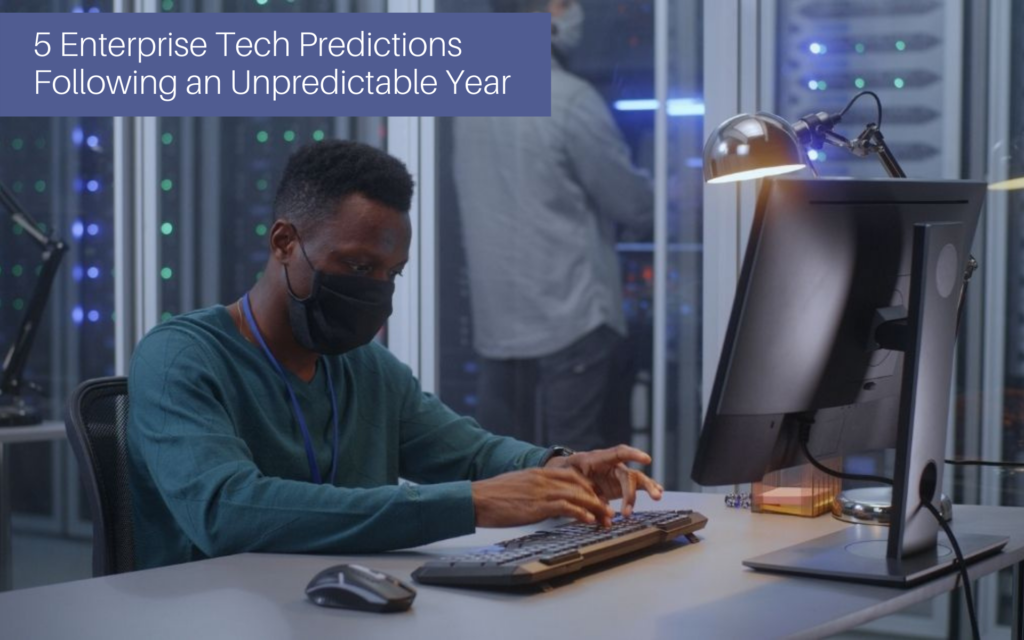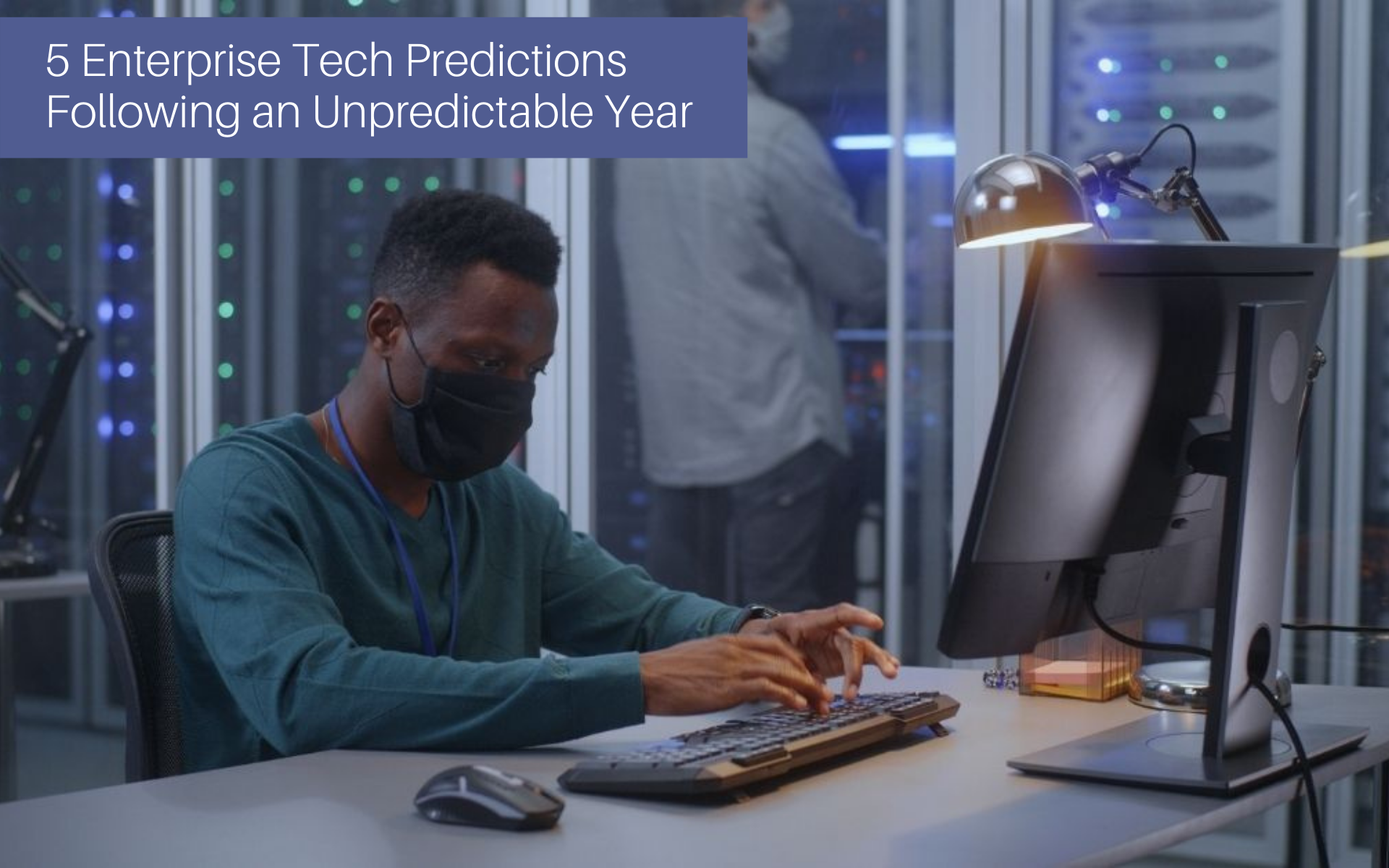
5 Enterprise Tech Predictions Following An Unpredictable Year
We all went into 2020 with a plan. Those plans were rendered irrelevant just a few months into the year. Organizations quickly rolled out contingency plans and put non-essential initiatives on hold. This may lead one to believe that 2020 was a wash for technology innovation. I would argue otherwise. In fact, organizations deployed inspired solutions to tackle considerable challenges.
Here are a few observations from 2020 and five enterprise tech predictions for 2021.
The Edge Is the New Frontier for Innovation
Amazing things are happening at the edge. We saw that on full display in 2020. Here are a few examples:
- When the pandemic first hit, a lab testing company rolled out 400 mobile testing stations across the United States in a matter of weeks.
- A retailer relocated their entire primary distribution center, which was in a state under stay-at-home orders, to fulfill an influx of e-commerce orders from a new location.
These organizations used existing edge investments to react and innovate with velocity. And in the year ahead, we will continue to see prioritized investment at the edge.
Network reliability and performance directly impacts employee and customer experience. That alone led to expansive SD-WAN rollouts at the edge and in-home offices. Simple SaaS-delivered solutions (inclusive of hardware) will further improve security and user experience wherever employees choose to work. And this will start a trend in which these solutions become the norm.
Additionally, I expect organizations to increasingly adopt a secure access service edge (SASE) solutions. Legacy network and security architectures create unnecessary hair pinning and performance degradation. Instead, our future will lie in application and infrastructure services that are defined in software and deployed and managed as software updates. While upending legacy procurement processes along the way, organizations will dramatically improve performance and security.
We are also getting far more intelligent at the edge, with the ability to learn, react and optimize in real-time. Furthermore, we are seeing new opportunities for infrastructure consolidation at the edge, reducing the number of specialized appliances required to meet technology needs. This is an exciting development as it opens doors for cost-positive solutions where you improve automation, safety, and efficiencies, while simultaneously reducing costs.
Decentralization of Machine Learning
Staying at the edge for another moment, let’s talk about federated machine learning (FML). We are starting to see early uptake in this area among businesses. Across all industries, organizations are innovating to make better data-driven decisions, while leveraging highly distributed technology footprints.
With compute capacity practically everywhere, federated learning allows organizations to train ML models using local data sets. Open source projects, such as FATE and Kubeflow, are gaining traction. I expect the emergence of intuitive applications on these platforms to further accelerate adoption.
Early ML solutions disproportionately benefited a small percentage of enterprises. These organizations had mature data science practices already in place. ML adoption continues to pick up pace. And that acceleration is driven by turnkey solutions built for “everyone else.” These are enterprises that want to reap the rewards of ML without having to make large investments in data science teams—often a difficult challenge given the industry shortage of data scientists today.
Renewed Momentum for Workplace 2.0 Initiatives
The pandemic brought renewed momentum for many Workplace 2.0 initiatives. I’m especially interested in augmented reality (AR) and virtual reality (VR) use cases.
AR and VR are gaining traction, especially in use cases like employee training, AR-assisted navigation (such as on corporate campuses), and in online meetings. This year, I had the opportunity to participate in a VR meeting. The cognitive experience was quite fascinating. While on a Zoom meeting, it’s quite obvious that you’re on a video call. But after a few minutes in a VR meeting, you start to feel like you are actually in the room together.
There’s still work to be done to drive mainstream adoption. 2021 will see gains in the adoption of AR and VR, aided by advancements in enterprise-class technologies that address security, user experience, and device management of these solutions.
That said, the biggest gap for VR, in my opinion, is that there is not an equivalent to Microsoft PowerPoint for VR. In other words, in the future, I want to be able to quickly create 3D content that can be consumed in a VR paradigm. Today, there simply is not an easy productivity tool that would allow anyone to quickly create rich 3D content that takes full advantage of the 360-degree panorama afforded by VR. I expect this to be an area of focus for AR and VR technologists moving forward.
Continued Evolution of Intrinsic Security and Data Protection
Innovations in the security space brought intrinsic security from what some called a marketing buzzword into something real.
For instance, today one can leverage virtualization technologies to secure a workload at the moment it is powered on, prior to even an operating system being installed. That is intrinsic security by definition and represents a major step forward from the traditional security model.
In 2021, security will once again be amongst the top technology investments for the year, with both ransomware and security at the edge getting increased attention. Sophisticated ransomware attacks are not just targeting data, but also data and system backups. This creates the potential that even system restores are compromised.
We need to change how we protect systems and data. We need to fundamentally rethink what it means to back up and recover systems. Legacy solutions with static protection and recovery approaches will start facing the potential for disruption as the year progresses.
When we look at the edge, a growing number of technology decisions are being made by the lines of business—sometimes even at a local level—and not central IT. This has long created challenges as smart and connected devices are deployed at edge sites faster than traditional IT processes. While we should always strive toward deploying compliant solutions, we need to accept the fact that business velocity and agility requirements can be in conflict.
To that end, we must look at technologies that offer broader discovery of connected systems at the edge and provide adaptive security policy enforcement for those systems. Instead of fighting the battle for control, security leaders must accept there is some degree of chaos and innovate with the expectation of chaos as opposed to outright control.
Applying New Technologies to Old Challenges
In 2021, what’s old may be new again—at least in taking another look at how new technologies can help solve old challenges.
For example, in the area of sustainable computing, there is a lot of energy efficiency to be gained in the traditional data center. VMware currently has an xLabs project to help our customers optimize hot and cool aisle spaces in their data centers. Early studies revealed a promising amount of energy efficiency can be gained through platform-driven data center heat management.
Additionally, machine learning may soon help improve accessibility. Earlier this month, we announced a project spearheaded by VMware technologists to help developers conduct better automated accessibility testing with machine learning. This project will make it easier for organizations to meet accessibility standards, while reducing costs for the software they build.
2020 was a year of determining progress. Unforeseen challenges taught us to plan and architect for the expectation of change. And we must be resilient to adapt to new ways of living and working.
2021 ushers in hope as we navigate whatever our new normal will be. And I’m excited to see how that new normal will be shaped by advancements in technology.
Author: Chris Wolf, VP, Advanced Technology Group, VMware
Source: https://www.vmware.com/radius/5-enterprise-tech-predictions-2021/
FOR A FREE CONSULTATION, PLEASE CONTACT US.





